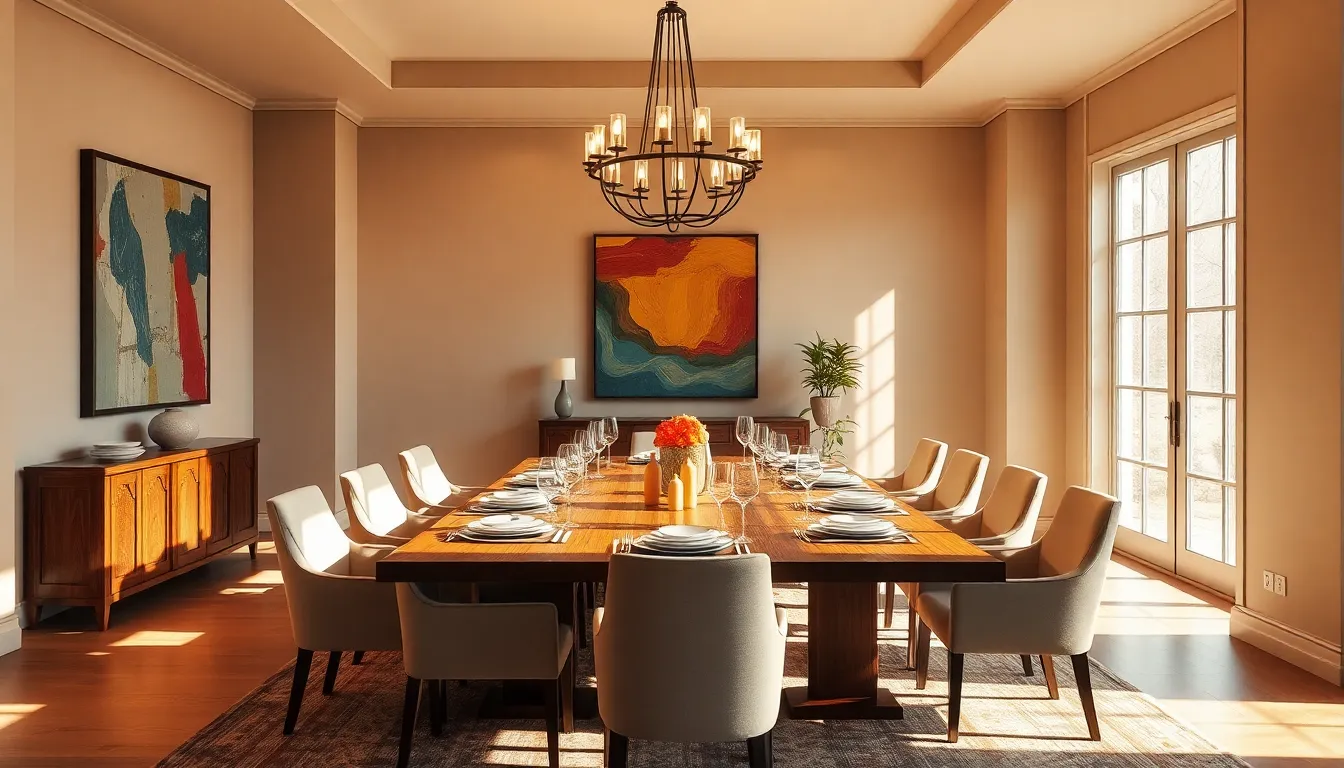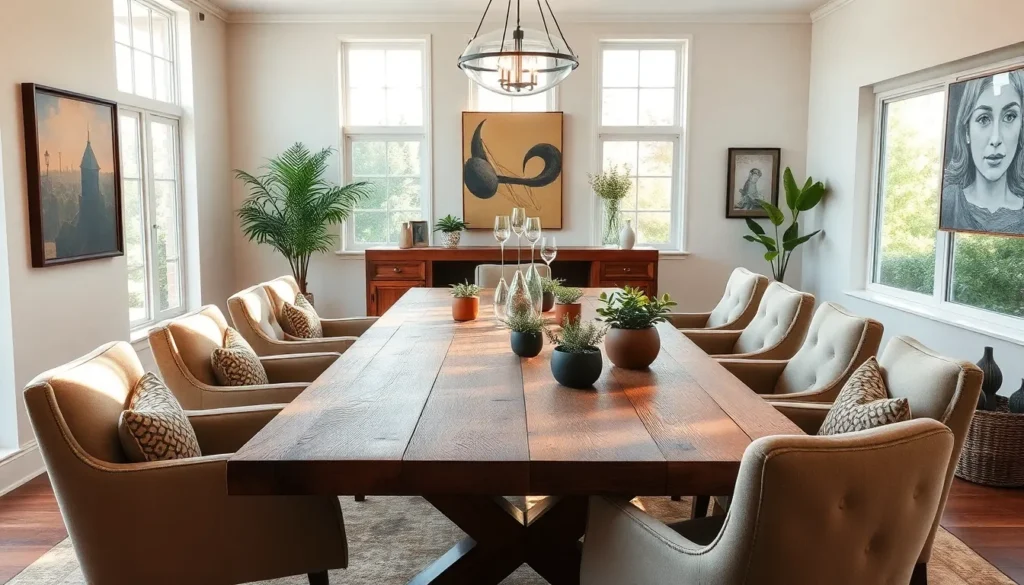In the world of home decor, the dining room is like that friend who always brings the best snacks to the party—essential and often overlooked. It’s where families gather, friends toast to life’s victories, and awkward conversations happen over burnt toast. Designing this space isn’t just about aesthetics; it’s about creating an atmosphere that invites laughter, connection, and maybe a few food fights (just kidding, sort of).
Dining Room Interior Design
Dining room interior design significantly impacts the overall ambiance of the home. It serves as a focal point for family gatherings and celebrations. A well-designed space promotes connection and interaction among guests. Considerations for color schemes, furniture, and layout transform the dining experience.
Aesthetic appeal increases with thoughtful design choices. Stylish furniture enhances comfort, encouraging guests to linger longer. Optimal lighting creates a warm atmosphere, setting the mood for any occasion. Practical elements like storage solutions ensure a clutter-free environment, making the space inviting.
Functionality also plays a key role in designing dining areas. Select tables and chairs that accommodate varying group sizes, ensuring flexibility for different occasions. Incorporate durable materials that withstand daily use while still being visually appealing. Smart design choices lead to an efficient use of space, enhancing flow and accessibility.
Creating a personal touch adds character to the dining room. Incorporating artwork or decorative items reflects personal style while enhancing the environment. Thoughtful choices of textiles, like tablecloths and cushions, contribute to a cohesive look. Every design decision should align with the desired atmosphere, whether formal, casual, or eclectic.
Ultimately, the dining room serves as more than just a place to eat. It embodies moments for socializing and building memories. Prioritizing quality design elevates this shared space, fostering deeper connections and enriching experiences among family and friends.
Key Elements Of Dining Room Design

Focus on key elements that enhance the dining room’s functionality and aesthetic appeal. Prioritizing furniture, color schemes, and lighting creates an inviting atmosphere.
Furniture Selection
Select furniture that complements the space and accommodates guests. Choose a dining table that fits the room’s dimensions while offering enough seating for gatherings. Prioritize comfort by selecting chairs with suitable cushioning and support. Consider materials like wood, metal, or upholstered pieces based on the desired style. Incorporate storage solutions like buffets or sideboards to keep dining essentials organized and within reach.
Color Scheme
Establish a color scheme to set the mood for the dining room. Neutral tones, such as beige, gray, or soft white, create a serene backdrop, allowing elements to shine. Incorporate bolder accent colors through décor items or artwork to add personality. Consider the psychological effects of colors; for instance, warm hues promote a cozy atmosphere while cool tones provide calmness. Use consistent shades throughout the space for cohesion.
Lighting
Opt for layered lighting to enhance the dining experience. Pendant lights or chandeliers above the table serve as focal points while providing essential illumination. Include softer ambient lighting through wall sconces or recessed fixtures to create warmth during intimate gatherings. Dimmable options offer flexibility for different occasions. Incorporate natural light through windows to connect the interior with the outdoors.
Popular Dining Room Styles
Dining rooms come in various styles, each with unique characteristics that foster different atmospheres. These popular dining room styles include modern, traditional, and rustic, each offering specific aesthetic and functional qualities.
Modern
Modern dining rooms emphasize clean lines and minimalistic design. They often feature simple furniture with sleek silhouettes and neutral color palettes. Decor typically includes geometric shapes and a focus on functionality. Large windows allow natural light to enter, creating an airy feel. Furniture pieces may incorporate materials like glass and metal, enhancing a contemporary ambiance. Seating options often include streamlined chairs that blend comfort with style. Overall, modern designs prioritize an uncluttered environment that promotes a sophisticated dining experience.
Traditional
Traditional dining rooms reflect a classic and timeless aesthetic rooted in historical influences. Wood furniture, rich colors, and intricate detailing often characterize this style. Large dining tables serve as focal points, accommodating families for gatherings and celebrations. Elegant lighting fixtures like chandeliers add grandeur to the space, enhancing its ambiance. Rugs typically anchor the dining area, providing warmth and definition. Materials such as dark woods and plush fabrics contribute to a cozy atmosphere, inviting guests to linger over meals and conversations.
Rustic
Rustic dining rooms focus on natural materials and cozy, inviting designs. A combination of reclaimed wood, stone accents, and earthy colors creates a warm environment. Furniture showcases a handcrafted appearance, reinforcing the connection to nature. Open floor plans encourage social interaction, making these spaces ideal for family gatherings. Decor often includes vintage pieces, enhanced by elements like wrought iron and handmade crafts. Textiles such as burlap or linen contribute to the relaxed feel. Overall, rustic styles foster a sense of comfort and nostalgia, perfect for cozy dinners with family and friends.
Tips For Small Dining Room Design
Maximizing space in a small dining room requires thoughtful design. Use round tables to create a more intimate setting, as they fit easily into corners. In addition, select lightweight chairs that can be tucked away to free up walking space. Include multi-functional furniture, like a bench that doubles as storage, to make the most of limited areas.
Colors play a crucial role in making small rooms feel larger. Light hues, such as soft whites or pale blues, reflect light, enhancing openness. Incorporate bold accents through decor items or artwork to add personality without overwhelming the space. Mirrors also work wonders; placing one strategically can create an illusion of depth and brightness.
Lighting design can significantly influence the atmosphere. Utilize pendant lights to draw attention upward, which adds height to the room. Layer ambient lights, like wall sconces, to soften the mood. Natural light, where available, should be maximized through sheer curtains or blinds that can be easily opened.
In terms of layout, keep walking paths clear to promote flow. Place the table in the center, allowing for easy access from all sides. Arrange furniture against walls to open up the room, providing flexibility for gatherings.
Finally, personal touches enhance character within small spaces. Adding plants gives a fresh and inviting feel, while unique artwork can serve as conversation starters. Prioritizing functionality and style creates a dining area that’s both practical and enjoyable.
Conclusion
A well-designed dining room is essential for creating memorable experiences. It serves as the heart of the home where connections are made and stories are shared. By focusing on thoughtful design elements like furniture selection color schemes and lighting, anyone can enhance the atmosphere of their dining space.
Incorporating personal touches and maintaining functionality will further enrich the environment. Whether embracing a modern minimalist aesthetic or a cozy rustic vibe the key lies in designing a space that resonates with its inhabitants. Ultimately a beautifully curated dining room not only elevates meals but also fosters lasting relationships and cherished moments.

